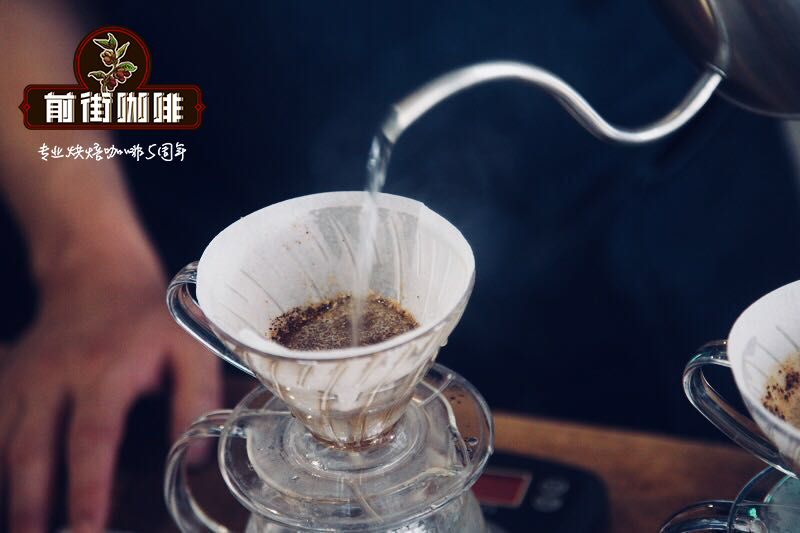You must learn the basic knowledge of a good cup of coffee.

Professional coffee knowledge exchange more coffee bean information please follow the coffee workshop (Wechat official account cafe_style)
You must learn the basic knowledge of a good cup of coffee.
What's the key to a good cup of coffee? Good brewing skills and utensils are indispensable, but high-quality coffee beans are the most important element. Do you have no idea about coffee beans, or are you often dizzy by a bunch of coffee nouns? It doesn't matter. In the following article, we will introduce the important knowledge about coffee beans in the easiest way.
Only when there are high-quality coffee beans can there be good coffee.
In Taiwan, drinking coffee has become an indispensable enjoyment, and more and more people choose to make coffee at home, not only for interest, but also for better coffee quality. If you have, or are planning to do, then the first thing you need to know is: good coffee comes from high-quality coffee beans.
This is the same as most food. A fish that is not fresh, no matter how gorgeous it is to cook, must not be very delicious, but a fresh fish, steamed with ginger, is very delicious. The same is true of coffee, poor quality coffee beans, no matter how good brewing skills or utensils can not be saved, destined to only make bad coffee.
So, what are high-quality coffee beans? Recall that you have had coffee that tastes good in the past. It probably has two characteristics: the first is the charming aroma, and the second is the good taste. Different varieties of coffee beans have different tastes, and personal preferences vary, of course, but the so-called high-quality coffee beans should be able to retain the aroma and flavor of the coffee as much as possible and emit it completely when it is brewed at the end.
The aroma of coffee comes from coffee roasting
The aroma and taste of coffee are produced after roasting. In the process of baking, the moisture of raw coffee beans is slowly released, the weight is reduced, the color deepens, the volume expands, and the aromatic oil is slowly released. In addition, a large amount of chlorogenic acid originally contained in raw beans will gradually disappear with the baking process, releasing good-smelling fruit acid, and its taste varies with the baking time. In the following picture, you can see the change in the shape of coffee beans during roasting.
Change of roasting color of coffee beans
We will elaborate on the details of roasting later. What you must know is that the special flavor of coffee is roasted, which is related to how to choose good coffee beans.
Coffee bean V.S. Coffee powder
Coffee bean coffee powder
After deciding to make your own coffee, the first choice you face when buying coffee is to buy coffee beans (whole coffee beans) or ground coffee powder (ground coffee beans). Leaving aside other personal equipment and time factors, we have only one suggestion: buy coffee beans, just buy coffee beans.
Of course, there is a reason for such a firm recommendation. Remember what we said earlier? The aroma of coffee comes from the roasted oil, which is sealed in the holes in the coffee beans. after grinding, the aroma and oil begin to volatilize, and the final brewed coffee flavor is greatly reduced.
In addition, the area of the powder in contact with the air increases and is vulnerable to moisture or deterioration. Under the same conditions, coffee beans can be preserved nearly twice as long as coffee powder.
The only advantage of coffee powder is its convenience, especially if you always oversleep in the morning and don't have time to grind your coffee slowly, or if you haven't bought tools to grind beans, coffee powder can help you enjoy a nice cup of coffee quickly. If you decide to buy coffee powder, then we have the following two suggestions: (1) buy about two weeks at a time, retain the flavor as much as possible, and (2) keep the coffee powder in a good sealed jar.
Is it troublesome to grind your own beans? In fact, it's fun and can maintain the flavor!
Coffee beans are the most complete form to preserve the flavor of coffee and ensure that the coffee is fresh and original. Some manufacturers will mix coffee from different sources in the same bag of coffee powder, so it is difficult for consumers to ensure the source of coffee.
Although grinding beans is also a great knowledge, believe us, once you start grinding your own beans, you will never go back to the days of coffee powder. It is definitely one of the joys of homemade coffee to try the different flavors of various powders.
The best time limit for coffee appreciation
There are quite a variety of coffee beans. How to choose them?
Are you still looking at the expiration date on the package before you buy the coffee? We want to tell you another important thing: the best taste period of coffee is not equal to the shelf life, you should pay attention to the baking time.
The roasting date of coffee beans represents freshness, and fresh coffee beans baked within 2-3 days are usually a good choice. However, baking and buying now is not actually the best time for beans to taste. In addition, coffee beans will continue to emit nitrogen dioxide (exhaust) for about 48 hours after baking, in addition to the smell of tobacco during baking and the smell of beans themselves. therefore, freshly baked coffee beans are not very tasty.
It is recommended to buy coffee beans for about 2 weeks at a time and keep them indoors. It is also recommended that the coffee beans should be used in 2 weeks when the flavor is the best and most delicious.
Types of coffee beans
At present, there are more than 100 kinds of coffee in the world, of which two of the most common are Arabica and Robusta/Canephora. These two kinds of coffee are very different in taste, composition and growing conditions. We will compare the differences between them below.
Robusta-Arabica-bean Araby Karobsta
Arabica: expensive, supple taste, low caffeine
Coffee advertisements often emphasize that they use 100% Arabica coffee. Yes, in terms of price alone, Arabica is indeed more advanced, the average price of Arabica coffee beans is twice that of Robusta.
In terms of composition, Arabica has low caffeine (0.9-1.2%), 60% more fat and twice as much sugar, so taken together, Arabica tastes sweet and soft, with a plum-like sour taste.
In addition, Arabica has lower chlorogenic acid (5.5-8%), and chlorogenic acid is not only antioxidant, but also an important component of resistance to pests, so Arabica is more vulnerable to insects and climate, generally planted at higher elevations, bearing less fruit and slower. The fruit is oval.
At present, Brazil is the largest grower of Arabica, while Colombia produces only Arabica coffee.
Robusta: cheap, bitter, high caffeine
In contrast, Robusta, which is high in caffeine (1.6-2.4%) and low in fat and sugar, tastes bitter and strong, and some even say it tastes rubber.
Robusta has a high content of chlorogenic acid (7-10%), which is not easy to be affected by insects and climate. It is generally planted at a low altitude, bearing many fruits and fast. The fruit is round.
At present, the largest grower of Robusta is Vietnam, which is also produced in Africa and India.
Price is not equal to quality.
Because of its low price, Robusta is often mixed with coffee powder on the market to reduce cost. at present, most of the cheap instant coffee on the market is robusta, but the price is not equal to quality. Good quality robusta beans are often used in espresso (espressos) because of its rich crema. Robusta with good quality tastes even better than Arabica beans with poor quality.
Therefore, the choice between the two kinds of coffee beans mainly depends on personal preferences. Some people may think that the aroma of Arabica is too strong, while others like Robusta's mellow bitterness. The only thing we want to remind you is that if you are sensitive to caffeine, pay special attention to the amount of caffeine. Robusta has twice as much caffeine as Arabica.
Of course, these are not the only two varieties of coffee, you can also try Java (Java), Kona (Kona), Sumatra (Sumatra) and other varieties to add new flavor to your coffee experience.
What do you recommend for coffee beans?
Coffee beans are recommended for fresh baking for 48 hours.
The flavor of coffee beans is affected by the process of origin, planting, processing, packaging, roasting, etc. How to select good quality coffee beans and how to identify the flavor you might like? You have to start by knowing the coffee beans.
The flavor of coffee
Before we get to the point, let's get to know a few proper terms to describe the flavor of coffee:
Acidity (acidity): the stimulation felt at the edge of the tongue when drinking coffee. Unlike the acid of lemon, coffee is a refreshing, refreshing feeling that boosts the taste, sometimes called brightness. Acidity is a very important characteristic of coffee, coffee without acidity will be very insipid.
Aroma: the aroma of brewed coffee is more varied than that felt by the tongue. The adjectives commonly used to describe the aroma of coffee are fruit-like, earthy, smoky, flowery, berries, nuts and so on.
Body: the taste of coffee in the mouth, from light as water or skim milk to thick as milk or cream, syrup.
Aftertaste: similar to the concept of wine tasting, refers to the taste that remains in the mouth after drinking coffee. Some coffee has the aftertaste of cocoa or chocolate, while others have fruit, berries, nuts and so on.
Balance (balance): this is an assessment of the overall taste of coffee. Good beans have a balanced, layered, and soft aroma, while bad beans usually show a single flavor.
In addition to the above proper nouns, there are several common adjectives that describe high-quality coffee:
Mellow: coffee with low to medium acidity and good balance.
Mild (mild): indicates that coffee has a harmonious, delicate flavor, usually refers to high-altitude South American coffee.
Soft: low-acidity, slightly sweet coffee, usually Indonesian coffee.
After knowing the term to describe the flavor of coffee, let's take a look at what factors affect the taste of coffee.
1. The origin of coffee beans
Amorous feelings of coffee bean producing area
Coffee connoisseurs all know: drinking depends on the year, drinking coffee depends on the origin. The soil, climate and altitude of the place of origin are the most fundamental elements to shape the taste of coffee. The taste of coffee grown from different places is naturally very different. Below we have sorted out the coffee flavor characteristics of several major producing areas for you:
Brazil: most Robusta is produced, with a strong taste and a chocolate finish. Coffee products in hypermarkets usually come from Brazil.
Central America, Colombia: light taste, good balance, low acidity and fruity finish. It is more popular in the United States.
Indonesia: earthy or smoky, bitter cocoa aftertaste, full-bodied.
Ethiopia: the origin of coffee is high in variety. Many are described as having a syrup smell and a strawberry or blueberry aftertaste.
Kenya: it's thick and a little sour with tomatoes.
Hawaii: sweet, mild, mellow and supple.
two。 The process of planting and treatment of coffee beans
In addition to the origin, the method of planting coffee beans (shade planting, organic cultivation, fertilization) and the process of picking coffee beans (whether the working conditions of farm workers enable them to have good working quality) also affect the taste of coffee. A good coffee tree may also produce bad beans.
The post-harvest treatment of coffee beans is also very important. there are three kinds of post-processing methods, such as sun exposure, water washing and honey treatment. Sun-dried coffee beans have rich fruit aromas, sweet aftertaste and high mellowness. Washed coffee beans have fruity or floral aromas, moderate acidity and low mellowness. Honey-treated coffee beans have a sweeter aftertaste, delicate fruit aromas and high mellowness.
At present, there are various grading methods in the world according to the size of coffee beans, the quality of post-processing, and planting elevation, which can also be used to judge the quality of coffee beans. In addition, some coffee packaging will have Fairtrade, sustainable management, organic cultivation, high altitude and other certification labels, most of the coffee beans with these labels are not poor. Although some proofs may not be directly related to quality, they indicate that the coffee beans have been carefully processed.
3. Preservation of raw coffee beans
Raw coffee beans are very stable before they are roasted and can be preserved for a year under good conditions. But if you put it in a place with high humidity, it may produce bacteria, and coffee beans will also be contaminated with the bad smell in the air.
It is worth mentioning that the so-called old beans (aged) refers to the coffee beans stored in the low humidity and high altitude environment of the country of origin, which are turned and kept fresh regularly to cultivate a particularly mellow taste. This kind of coffee bean tastes good, but it is also expensive. The coffee beans stored in the general warehouse are not old beans, so don't be deceived.
4. Roasting of coffee
Coffee bean roasting and cooling
The baking time of beans will affect the appearance and taste. The simplest way to judge is that the longer the beans are roasted, the lighter the sour taste and the less caffeine. Below we briefly list the coffee flavor produced by different roasting time for your reference.
Very shallow baking (light roast): has a strong smell of grass, lack of aroma, rarely used for tasting.
Light roasting (cinnamon roast): high acidity, slightly fragrant, often used to make American coffee.
Medium roasting (medium roast): sour and bitter taste, moderate aroma, retain the original flavor of coffee beans, often used to make American coffee or mixed coffee.
Medium and deep baking (high roast): the taste is rich, sour and bitter balanced and slightly sweet, with good aroma and flavor.
Urban roasting (city roast): lower acidity than medium and deep roasting, perfect display of coffee flavor, is the standard roasting degree, the most popular among the general public.
Deep roasting (full city roast): bitterness is stronger than sour taste, the aftertaste is sweet, full of aroma, mostly used to make iced coffee or black coffee.
French baking (French roast): bitter, strong, not sour, with a smoky aroma.
Italian roast: beans are glossy, bitter and scorched, and are mainly used to make espresso.
You can get the basic knowledge of identifying coffee beans from the above introduction, and find out your favorite taste by actually tasting different flavors of coffee beans. After reading this article, congratulations on entering the world of coffee. Let us repeat that a good coffee bean is the beginning of a good cup of coffee.
Important Notice :
前街咖啡 FrontStreet Coffee has moved to new addredd:
FrontStreet Coffee Address: 315,Donghua East Road,GuangZhou
Tel:020 38364473
- Prev

How do you plant coffee trees? Its growth process, what are the growth conditions?
Professional coffee knowledge exchange more coffee bean information please follow the coffee workshop (Wechat official account cafe_style) how to grow coffee trees? Its growth process, what are the growth conditions? 1. Nursery preparation: attention should be paid to shading effect in nursery selection. Seedlings exposed to direct sunlight are easy to die and reduce the survival rate. Therefore, the nursery must have shading equipment, shading materials can
- Next

It's no longer brown coffee? Is it still coffee?
Professional coffee knowledge exchange more coffee bean information Please note that the coffee workshop (Wechat official account cafe_style) is no longer brown coffee? Is it still coffee? It can be said that the reason for making colorless coffee is the love of beauty. It may not be so easy to love coffee and maintain healthy white teeth. In Taiwan, our happy health insurance gives us the ability to wash our teeth every six months.
Related
- Beginners will see the "Coffee pull flower" guide!
- What is the difference between ice blog purified milk and ordinary milk coffee?
- Why is the Philippines the largest producer of crops in Liberia?
- For coffee extraction, should the fine powder be retained?
- How does extracted espresso fill pressed powder? How much strength does it take to press the powder?
- How to make jasmine cold extract coffee? Is the jasmine + latte good?
- Will this little toy really make the coffee taste better? How does Lily Drip affect coffee extraction?
- Will the action of slapping the filter cup also affect coffee extraction?
- What's the difference between powder-to-water ratio and powder-to-liquid ratio?
- What is the Ethiopian local species? What does it have to do with Heirloom native species?

